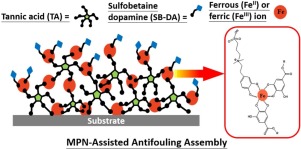当前位置:
X-MOL 学术
›
Colloids Surf. B Biointerfaces
›
论文详情
Our official English website, www.x-mol.net, welcomes your feedback! (Note: you will need to create a separate account there.)
A versatile approach to antimicrobial coatings via metal-phenolic networks.
Colloids and Surfaces B: Biointerfaces ( IF 5.8 ) Pub Date : 2020-01-02 , DOI: 10.1016/j.colsurfb.2020.110771 Meng-Ping Ko , Chun-Jen Huang
Colloids and Surfaces B: Biointerfaces ( IF 5.8 ) Pub Date : 2020-01-02 , DOI: 10.1016/j.colsurfb.2020.110771 Meng-Ping Ko , Chun-Jen Huang

|
This study reports a newly developed approach for an antimicrobial coating using coordination of functional catechol, polyphenols and metal ions in an aqueous solution. Bioinspired zwitterionic sulfobetaine dopamine (SBDA) provides fouling resistance, with tannic acid (TA) and metal ions serving as agents for surface conditioning. Films were formed by adsorption of a metal-phenolic complex network (MPN) on various planar organic and inorganic substrates. Because of its super-hydrophilic and charge-balanced properties, SBDA develops a tightly-bound water layer on top of the complex network to repel nonspecific adsorption. We compare ferrous ion (FeII) and ferric ion (FeIII), estimating their stabilities with phenol groups by measuring the binding constant. Surface hydration of the modified substrates was tested by contact angle goniometer; the surface elemental composition and the chemical states of the modified substrates were confirmed by X-ray photoelectron spectroscopy (XPS). To examine antifouling properties, modified substrates were immersed in solutions containing bacteria or mammalian cells. The adsorbed bacteria and cells were quantified using fluorescence microscopy and cell imaging analysis, showing the good antifouling properties of MPN-assembled zwitterionic coatings. Coatings were applied on various substrates, including silica, metal oxides, and plastics. The results show that zwitterionic SBDA can be coated on different surfaces via assembly of MPN, providing an antimicrobial treatment. This approach for substrate modification offers a facile and environmentally friendly means to realize biocompatible coatings for many types of substrates. The work also provides insight into the construction of hierarchical structures by molecular assembly for functional biointerfaces.
中文翻译:

通过金属-酚醛网络形成抗菌涂层的通用方法。
这项研究报告了一种新开发的抗菌涂层方法,该方法通过在水溶液中配位功能儿茶酚,多酚和金属离子来实现。受生物启发的两性离子磺基甜菜碱多巴胺(SBDA)具有抗污性,单宁酸(TA)和金属离子可作为表面调节剂。通过在各种平面有机和无机基材上吸附金属-酚类络合物网络(MPN)来形成薄膜。由于具有超亲水性和电荷平衡特性,SBDA会在复杂网络的顶部形成紧密结合的水层,以排斥非特异性吸附。我们比较了亚铁离子(FeII)和铁离子(FeIII),通过测量结合常数估算了它们与酚基团的稳定性。通过接触角测角仪测试改性基材的表面水合作用;通过X射线光电子能谱(XPS)证实了改性基材的表面元素组成和化学状态。为了检查防污性能,将改性基质浸入含有细菌或哺乳动物细胞的溶液中。使用荧光显微镜和细胞成像分析对吸附的细菌和细胞进行定量,显示了MPN组装的两性离子涂层的良好防污性能。将涂料涂在各种基材上,包括二氧化硅,金属氧化物和塑料。结果表明,通过MPN的组装,两性离子SBDA可以涂覆在不同的表面上,从而提供了抗菌处理。这种用于基材改性的方法提供了一种简便且环保的方法,可为多种类型的基材实现生物相容性涂料。
更新日期:2020-01-02
中文翻译:

通过金属-酚醛网络形成抗菌涂层的通用方法。
这项研究报告了一种新开发的抗菌涂层方法,该方法通过在水溶液中配位功能儿茶酚,多酚和金属离子来实现。受生物启发的两性离子磺基甜菜碱多巴胺(SBDA)具有抗污性,单宁酸(TA)和金属离子可作为表面调节剂。通过在各种平面有机和无机基材上吸附金属-酚类络合物网络(MPN)来形成薄膜。由于具有超亲水性和电荷平衡特性,SBDA会在复杂网络的顶部形成紧密结合的水层,以排斥非特异性吸附。我们比较了亚铁离子(FeII)和铁离子(FeIII),通过测量结合常数估算了它们与酚基团的稳定性。通过接触角测角仪测试改性基材的表面水合作用;通过X射线光电子能谱(XPS)证实了改性基材的表面元素组成和化学状态。为了检查防污性能,将改性基质浸入含有细菌或哺乳动物细胞的溶液中。使用荧光显微镜和细胞成像分析对吸附的细菌和细胞进行定量,显示了MPN组装的两性离子涂层的良好防污性能。将涂料涂在各种基材上,包括二氧化硅,金属氧化物和塑料。结果表明,通过MPN的组装,两性离子SBDA可以涂覆在不同的表面上,从而提供了抗菌处理。这种用于基材改性的方法提供了一种简便且环保的方法,可为多种类型的基材实现生物相容性涂料。

























 京公网安备 11010802027423号
京公网安备 11010802027423号